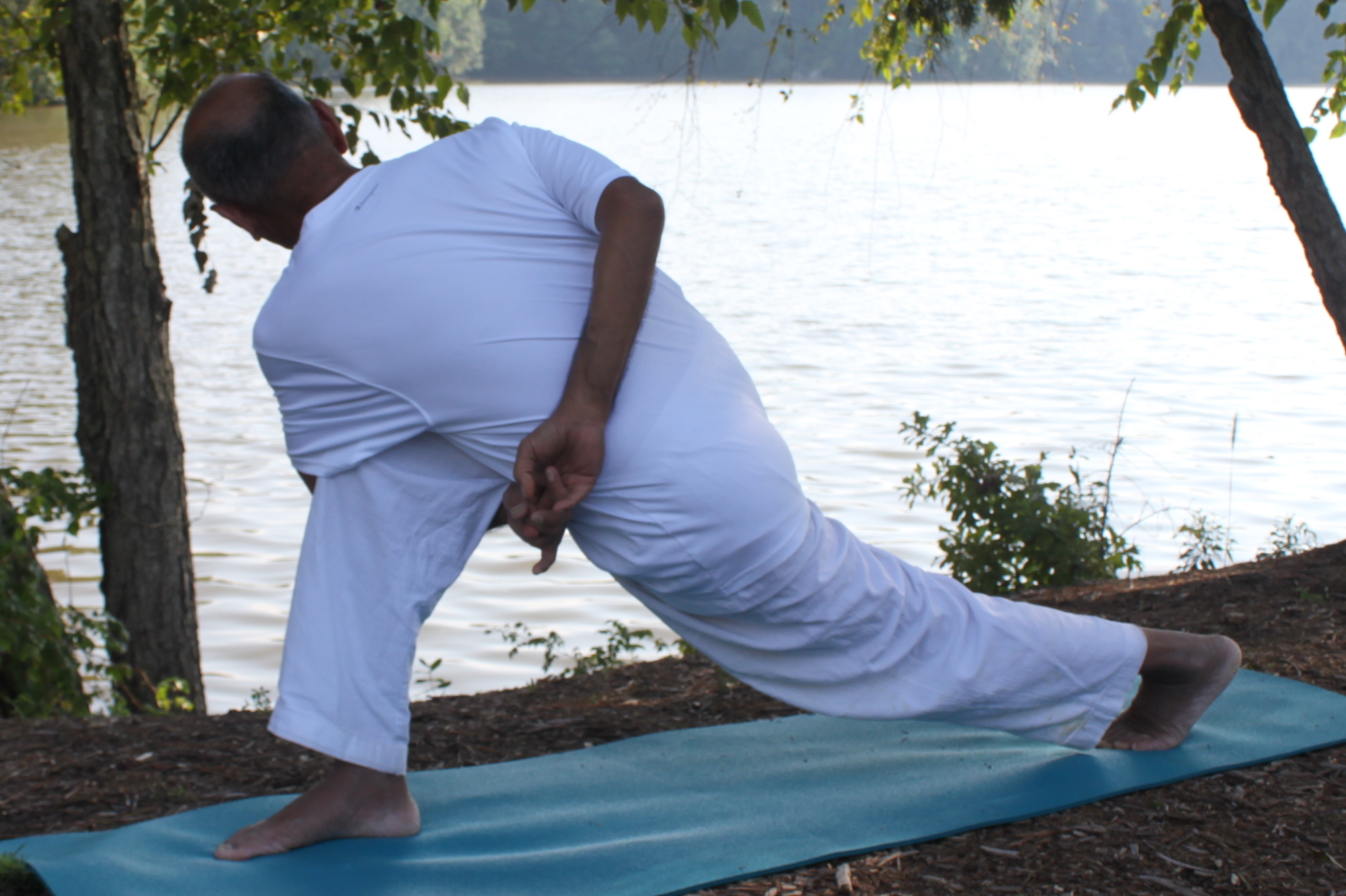
Baddha Parshvakonasana
(bound side angle pose)
Most of the classes that I teach last 1.5 hours. In almost every class I emphasise the need for establishing a home-based yoga practice which can be done on a daily basis. However, students who feel committed to practice at home are usually faced with the following predicament:
- For most, it is not possible to allocate 1.5 hours every day for the yoga practice. Some are willing to allocate no more than one hour, even that being a stretch.
- Others are willing to allocate between 30 – 60 minutes, almost on a sliding scale, depending upon variability in their day-to-day schedule.
- In the regular 1.5 hour group class, we practice many asanas with variations, yoga nidra and different pranayama techniques. We also discuss the concepts of meditation and practice meditation on a few occasions.
- If we want to limit the practice to one hour or less, the main question is how to structure the sequence so all aspects of yoga are covered.
Many of my students have asked me to provide a 30-minute sequence which is largely based on asana practice. They are willing to practice the other aspects – yoga nidra, pranayama and meditation as and when time permits.
I am pleased to present a 30-minute asana-based sequence. I hope you will enjoy practicing with me using this video.
The following asanas and pranayama are covered in this sequence:
- Centering and Om chanting
- Marjarasana (Cat and Cow)
- Surya Namaskar (Sun Salutation) – 2 rounds with Warrior 1 as one of the variations
- Vrikshasana (tree pose)
- Dhanurasana (Bow pose)
- Pashchimottanasana (full forward bend)
- Setu-bandhasana (Bridge pose)
- Ardha-matsyendrasana (spinal twist)
- Yoga Mudra
- Kapalabhati
- Nadi Shuddhi (alternate nostril breathing)
If you need specific instructions on any of the above practices, please search my blog for the practice. You may also visit my youtube channel for more details.
General guidelines for the yoga practice
- Yoga must be practiced on an empty stomach. Give at least a three hour gap between a meal and the yoga practice.
- The best time to practice yoga is in the morning, after completing your morning ablutions, and before breakfast.
- If you are unable to allocate the full one hour in the morning, you may split the practice, depending upon your convenience, between morning, afternoon and evening. For example, you may like to practice asana in the morning, pranayama in the afternoon (before lunch) and meditation in the evening. Any other combination is possible.
- It is best to allocate a clean, isolated spot in your home for the practice. Try to keep the space clean, without clutter and without any potential distractions. You may want to unplug the phone, turn the TV off, switch off all sounds from the computer etc. before starting the practice.
- Practice with full awareness of body, breath and the mind. At no time you should strain or overstretch your body or the breath.
- Have fun!
I would love to hear your feedback. Please post your thoughts in the comments section below.
Thank you very much Subhash, I enjoyed this practice very much and found the repeating of Kapalbhati at both the beginning and end of the practice very interesting. I am surprised how they felt different, i.e.I felt freer and more open in my abdo and breath towards the end of the practice. Yet again, a testiment to usefulness of even a relatively short class.
Thank you for your generosity and useful and clear instruction.
Om shanti,
josephine
It is an interesting observation that you found the practice of kapalabhati more free and open at the end of the session. So glad that you enjoyed the 30-minute routine. As I always like to add – you should try to allocate additional time for more pranayama and meditation.
Perfect short sequence! It is going to be my routine when I cannot do a full practice. I add a brief Savasana as time allows. Thank you, Subhash, for sharing this. Sending blessings and joy.
Thanks, Janis, for your kind feedback. So glad you find the sequence helpful in your own practice.
This seems like a good routine and great guidelines, but I learned from you that there is no ‘one-size fits all’ ideal routine. I just aim, as you once advised, to include about 1/3 each of Asana, Pranayama and Meditation based on my available time. I have my favorite Asanas that my body seems to need more because of areas I accumulate stress, injuries, and weaknesses and try not to avoid Asana’s just because they are more challenging. I needed more of a structure before I developed a decent repertoire (with your help) but now i find approaching things intuitively works best for me!
Roger, good to hear from you. You are right – there is no “one size fits all”. This is just an effort to encourage everyone to commit to a daily routine. As you said, over time, they will build up their own individual routine. It is nice to know that you are using intuitive wisdom to mold your routine.
i use Swami Sachchthanantha’s recording for 1 1/2 hours .
That’s nice. Is that an audio recording? Where do you get it?